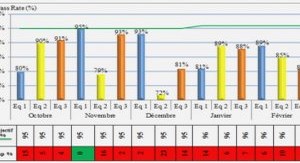Étude des effets d’un plasma froid d’air ambiant sur la physiologie des graines d’Arabidopsis
Plant material
Arabidopsis (ecotype Columbia Col-0) seeds were grown and harvested dormant following the method described by Leymarie et al. (2012), and then stored at -20 °C to keep dormancy properties. All seeds have an initial moisture content of 7 %DW. Three batches were formed to carry out the following experiments: (i) plasma-seeds interactions, (ii) water sorption isotherms and (iii) LCR measurements. 2.2. Equilibrating seeds to specific water contents According to the method described by Vertucci and Roos (1993), several equilibrium water contents (WC) were obtained by placing Arabidopsis seeds in different hermetically sealed jars, at 20 °C for 4 days. Seeds were placed over silica gel and saturated salt solutions of ZnCl2, LiCl, CaCl2, MgCl2, Ca(NO3)2, NaCl, KCl and KH2PO4, hence resulting to the respective values of relative humidities (RH): 2.5, 9.5, 17.0, 28.5, 40.0, 56.5, 75, 83.5 and 93.0 %. Seed water content, expressed on a dry weight basis (DW) in g.H2O.g DW-1 , was calculated as the mass ratio of a given number of seeds equilibrated in an atmosphere of controlled relative humidity by the same number of seeds in a totally anhydrous state. Therefore, for each condition of relative humidity, three replicates of fresh seeds (approximately 15 mg of seeds per replicate) were dried during 24 h at 105 °C. The mass ratio between water-equilibrated mass to anhydrous mass resulted in the seed water content. In this work, values of WC were expressed as the mean of the three replicates with its standard deviation.
Water sorption empirical models and water sorption isotherms
Sorption isotherm curves were obtained by plotting WC as a function of RH, whether for seeds from control groups or plasma groups. Sorption isotherms were fitted to experimental data points (RH, WC) by using four types of empirical models relying on seed thermodynamic properties and providing biological and physical parameters of the water sorption phenomenon which operates on seed tissues. Each of these models was applied using the fitting tools of the Originlab software. The fitting parameters were extracted with their errors while the accuracy of the fit was given by the R-squared coefficient. In this study, several commonly used models were considered to determine such parameters from experimental data: the Brunauer-Emmett-Teller (BET) model, the Guggenheim-Andersonde Boer (GAB) model, the D’Arcy and Watt (D&W) model and the Generalized D’Arcy and Watt (GDW) model. 2.3.1. The Brunauer-Emmett-Teller (BET) model One of the first thermodynamic models describing water sorption within multimolecular layers is the BET model (Brunauer et al., 1938), described by equation (2): 𝑊𝐶 = 𝑀𝑚𝐶𝑅𝐻 (1 − 𝑅𝐻)(1 + (𝐶 − 1)𝑅𝐻) (2) Where WC (%DW) is the seed water content, RH (%) is the relative humidity, Mm is the water content of the monolayer adsorbate (dimensionless quantity, normalised to 1) and C is a temperature-dependent coefficient (dimensionless). The BET model is relevant to assess WC values for RH < 50 % and is no longer accurate beyond (Black and Pritchard, 2002). This model is very useful to estimate the quantity of strong binding sites where water is bound as a monolayer. 2.3.2. The Guggenheim-Anderson-de Boer (GAB) model The GAB model was developed as an extension of the BET model. It considers that water sorption is achieved in a multilayer region, hence the appearance of a third constant (K), as reported in equation (3): 𝑊𝐶 = 𝑀𝑚𝐶𝐾𝑅𝐻 (1 − 𝐾𝑅𝐻)(1 − 𝐾𝑅𝐻 + 𝐶𝐾𝑅𝐻) (3) Chapter 2: Interactions between Arabidopsis seeds and cold ambient air plasma: deciphering the role of seed water content, sorption sites and bioelectrical parameters 82 Where K is the multilayer parameter (dimensionless) and C the temperature dependent coefficient (dimensionless). Usually, the GAB model is valid between 5 and 90 % of relative humidity (Black and Pritchard, 2002). 2.3.3. D’Arcy and Watt (D&W) model The D&W model is a classical model developed by D’Arcy and Watt (D’Arcy and Watt, 1970), describing water sorption of non-homogeneous sorbents with three distinct terms related to (i) the monolayer adsorption by strongly binding sites, (ii) the monolayer adsorption by weakly binding sites and (iii) the multilayer adsorption by multimolecular sorption sites. The model is described by equation (4): 𝑊𝐶 = 𝐾𝐾 ′𝑅𝐻 1 + 𝐾𝑅𝐻 + 𝑐𝑅𝐻 + 𝑘𝑘 ′𝑅𝐻 1 − 𝑘𝑅𝐻 (4) Where K, K’, c, k and k’ are specific parameters for calculating the numbers of sites related to the three terms. The numbers of strong sorption sites, weak sorption sites and multimolecular sites are given by K’N/M, cN/(Mps) and k’N/M respectively, where N is the Avogadro number, M the molecular weight of water per sorption site (in grams) and ps the vapour pressure at the studied temperature (2338.8 Pa at 20 °C). WC values can be accurately estimated on the full RH range.
Generalized D’Arcy and Watt (GDW) model
As with the D&W model, the GDW model considers the existence of primary Langmuir-type adsorption sites on the inner/external walls of the seeds. Each site can adsorb one water molecule which, in turn, can become a secondary adsorption site. The GDW model relies on two assumptions: (i) each water molecule adsorbed on a primary site does not necessarily form a subsequent secondary site, (ii) a water molecule attached to a primary site can form several secondary sites. Kinetic considerations allow to write the GDW model as given by equation (5) (Furmaniak et al., 2007): 𝑊𝐶 = 𝑎𝑚𝐿𝑝𝑠𝐾𝐿𝑅𝐻 1 + 𝑝𝑠𝐾𝐿𝑅𝐻 1 − 𝑐(1 − 𝜔)𝑅𝐻 1 − 𝑐𝑅𝐻 (5) Where 𝑎𝑚𝐿 is the surface concentration of primary Langmuir-type adsorption sites (mol.g-1 ), KL is the Langmuir constant characteristic of the interaction between water and tissue (Pa-1 ), c is a kinetic constant related to the adsorption on secondary sites (dimensionless) and ω is the ratio of water molecules adsorbed on primary sites that are converted to secondary sites (dimensionless). In comparison with the three previous models, the GDW model presents two major assets: (i) it describes the sorption isotherm as a whole, from 0 to 100% of relative humidity and (ii) the value of adsorption on primary sites 𝑎𝑝𝑟𝑖𝑚 (mol.g-1 ) can be derived from 𝑎𝑚𝐿 as given by equation (6): 𝑎𝑝𝑟𝑖𝑚 = 𝑎𝑚𝐿𝐾𝐿𝑝𝑠 1 + 𝐾𝐿𝑝𝑠 (6) 2.4. LCR measurements To perform LCR measurements, the Arabidopsis seeds were placed in a coaxial cylindrical capacitor (CCC) constituted of two copper electrodes (Figure 1) with inner (a) and outer (b) radii of 2 mm and 5 mm respectively. The two electrodes were nested in a polymer structure (polylactic acid) so that the interelectrode space was filled with seeds to a height (h) of 3 mm. Measurements were performed for frequencies ranging from 20 Hz to 200 kHz. Then, the electrical capacitance and resistance of seeds samples were measured using an LCR meter (HM-8118 model from Rohde & Schwarz company). Figure 1 – Sketch of the coaxial cylindrical capacitor (CCC) containing Arabidopsis seeds in its interelectrode space to achieve their LCR measurements. First, LCR meter calibration was performed for all frequencies in the open circuit (two clips separated from each other) and then in the short circuit (two clips connected). Second, the capacitance and resistance of the CCC were measured without any seeds inside the interelectrode space. Third, 100 mg of Arabidopsis seeds was introduced so as to completely fill the interelectrode space. The parallel-equivalent capacitance and resistance of the seed amount ware measured while the dielectric constant (𝜀 ′ ), the dielectric loss Chapter 2: Interactions between Arabidopsis seeds and cold ambient air plasma: deciphering the role of seed water content, sorption sites and bioelectrical parameters 84 factor (𝜀 »), the conductivity (𝜎) and the loss tangent (𝑡𝑎𝑛𝛿) were derived (Nelson and Stetson, 1976). The dielectric constant was calculated as the ratio of two capacitances: coaxial cylindrical capacitor with seeds (C) by coaxial cylindrical capacitor without seeds (C0) (Berbert et al., 2001), as proposed in equation (7): 𝜀 ′ = 𝐶 𝐶0 (7) The dielectric loss factor was derived from the ratio of two terms: (i) a numerator corresponding to the difference of the conductance with seeds (G) and the conductance without seeds (G0), (ii) a denominator corresponding to the product of the angular frequency by the capacitance of CCC without seeds (C0) (K. C. Lawrence and S. O. Nelson, 1993), as written in equation (8): 𝜀 ′′ = 𝐺 − 𝐺0 2𝜋𝑓𝐶0 (8) The electrical conductivity (𝜎) of a dielectric material is expressed in S.m-1 and is characterised by its ability to let electrical charges pass freely through a body. It is given by equation (9) and directly depends on angular frequency and dielectric parameters (Nelson, 2015): 𝜎 = 𝜔𝜀0𝜀 ′′ (9) Finally, the loss tangent related to the electric power dissipation in the dielectric material can be calculated as the ratio between the dielectric loss factor and the dielectric constant, as expressed in equation (10): 𝑡𝑎𝑛𝛿 = 𝜀 » 𝜀 ′ (10) The measurements were repeated four times for three values of water contents: low water content (LW) at 3 %DW, medium water content (MW) at 10 %DW and high water content (HW) at 30 %DW. All results are expressed in nF for the capacitance and MΩ for the resistance corresponding to the mean of the 4 measurements with its standard deviation.
Experimental configuration of cold plasma in ambient air (source and electrical probes)
A dielectric barrier device (DBD) in a plan-to-plan configuration with a gap of 1 mm was used in this study. As shown in Figure 2, it was composed of a 2mm thick dielectric barrier and two electrodes: an electrode biased to the high voltage (stainless-steel mesh with a 100 µm nominal opening, a wire diameter of 71 µm and an open area of 34 %) and a counterelectrode which is grounded (bulk alumina plate). The area of the reactor was 30×40 cm2 . The mesh electrode was powered with a high voltage generator composed of a function generator (ELC Annecy France, GF467AF) and a power amplifier (Crest Audio, 5500W, CC5500). The power supply was completed by a ballast resistor (250 kΩ, 600 W) to limit current. Figure 2 – Experimental setup of the dielectric barrier device (DBD) used to generate ambient air cold plasma and treat Arabidopsis seeds in 1 mm electrodes gap; a capacitor C and a current probe are placed in series with the DBD to characterize the micro-discharges observed with an oscilloscope. Voltages and currents of the DBD were measured using a digital oscilloscope (model wavesurfer 3054 from Teledyne LeCroy company), with a 500 MHz bandpass and a 4GS/s sample rate. The voltage applied to the mesh electrode was measured with a high voltage probe (Tektronix P6015A 1000:1, Teledyne LeCroy PPE 20 kV 1000:1). The discharge current was monitored using a current transformer (Pearson company, model 2877) placed between the counter-electrode and the ground. A measurement capacitor (80 nF) was inserted between the counter-electrode and the ground so as to plot Lissajous curves. Their closed contour area was calculated to deduce the energy dissipated in the DBD. Multiplying this value by the operating frequency provided the electrical power injected in the DBD. The DBD source could process large quantities of Arabidopsis seeds, although each treatment was limited to 500 mg of Arabidopsis seeds (during 15 min) for the purposes of our experiments.
Résumé substantiel |




